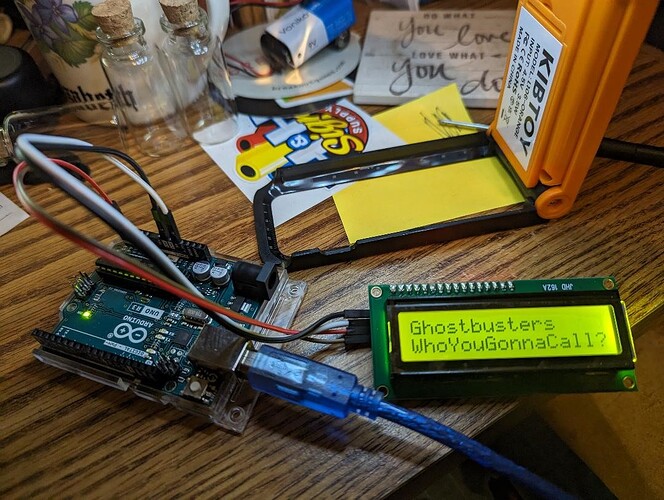Thanks for that link. I did not try this with the breadboard first. The LCD was already soldered with the l2c, because quite frankly all the attempts I've tried at soldering have gone terrible. I use just about any power tool but haven't got the hang of that thing yet. I was trying to avoid it. But I'm starting to wonder if that is where the issue lies.
Try again with your shortest jumper wires on A5/A4 (power and ground can be any reasonable length). IIC (inter-integrated-circuit) is made for short runs on a circuit board. and post a picture of the (each?) LCD showing the results
He's got a backpack on it, the jumper to the ardu won't matter, I have run 6 feet of 20AWG on those.
Please show the code that you are using. This should be VERY simple,
#include <LiquidCrystal_I2C.h>
LiquidCrystal_I2C lcd(0x27, 20, 4); // 20 is columns and 4 is rows
.
.
. //in setup;
lcd.init();
lcd.clear();
lcd.backlight();
lcd.setCursor(0, 0);
lcd.print("you are winner");
Your solder job looks good so no issues there. Need to see your project code.
Also regarding wires, for an I2C LCD they CANNOT be loose AT ALL
...
don't say you meant this sketch while name this topic
So I took the various advice I was given and played around with different wiring and a sketch from another library I had installed and for some reason it worked. I changed the sketch a little because I didn't like the backlight flashing that was written into it and I have success. But now I want to know why this one worked so I can learn what I did wrong. What does everyone think?
```cpp
/*
LCD_I2C - Arduino library to control a 16x2 LCD via an I2C adapter based on PCF8574
Copyright(C) 2020 Blackhack <davidaristi.0504@gmail.com>
This program is free software : you can redistribute it and /or modify
it under the terms of the GNU General Public License as published by
the Free Software Foundation, either version 3 of the License, or
(at your option) any later version.
This program is distributed in the hope that it will be useful,
but WITHOUT ANY WARRANTY; without even the implied warranty of
MERCHANTABILITY or FITNESS FOR A PARTICULAR PURPOSE.See the
GNU General Public License for more details.
You should have received a copy of the GNU General Public License
along with this program.If not, see < https://www.gnu.org/licenses/>.
*/
#include <LCD_I2C.h>
LCD_I2C lcd(0x27); // Default address of most PCF8574 modules, change according
void setup()
{
lcd.begin(); // If you are using more I2C devices using the Wire library use lcd.begin(false)
// this stop the library(LCD_I2C) from calling Wire.begin()
lcd.backlight();
}
void loop()
{
lcd.print("Ghostbusters"); // Display text
lcd.setCursor(0, 1); // Or setting the cursor in the desired position.
lcd.print("WhoYouGonnaCall?");
delay(500);
}
This topic was automatically closed 180 days after the last reply. New replies are no longer allowed.
